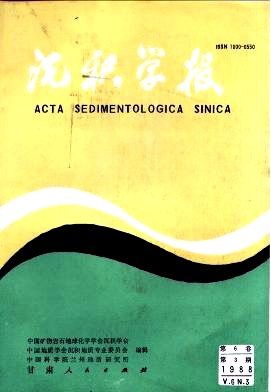CELESTITES OF CARBONATE IN YONGHE, LIUYANG COUNTY,HUNAN PROVINCE
- Received Date: 1986-07-07
- Publish Date: 1988-09-10
Abstract: The celestites ( SrSO4) , found in Yonghe, Liuyang County, Hunan Province, wich occur in carbonates of the Chihsia formation of the Lower Permian, are associated with sepiolite deposites. Since the celestite is an important industrial mineral, the discovery of it in this area is of some economic value. The single crystals of the celestite in Yonghe are long-column. Commonly surrounds the siliceous detritus and shows druses texture as chrysanthemum shape.Therefore,it is called "chrysanthemum-stone" too. By the observation of microscope, the refractive index and the other optical properties of the celestite are as follows: Ng = 1.630, Np = 1.622, positive biaxial crystal and middle ( 2V ) angle. Its X-ray diffraction pattern is characterised by peaks, d = 2.731 A , d = 3.972 A , d = 3.295A.There is another characteristic peak of the calcite,d = 3.03 A .In the infrared absorption spectrum pattern there is spectrum of the standard celestite such as 1295.16cm-1, 1195.56cm-1, 1136.81cm-1, 1090.76cm-1, 991.81cm-1, 640.74cm-1, and 610.64cm-1.The differential thermal analysis ( DTA ) curve shows two endothermic peaks. One is relateed to 740°C, perhaps this results from a small amount of the carbonate mineral in the sample. Another appears at 1146°C and its shape is sharp and wide.This is the characteristic peak of celestite created by the isodimorphism.From the analysis results mentioned above, the authors consider that the mineral composition of the celestite deposited in Yonghe is mainly celestites and a few calcites. The chemical composition of the celestite from Yonghe is as follows: SrO 54.21%,CaO 1.65%,MgO 0.25%,BaO 0.01%,A12O3 0.04%, Fe 2O3 0.02% and SO343.32% According to the calculation of oxygenatom, its crystal-chemcal formula is (Sr 0.97600, Ba0.0012)0.97612SO4. The origin of the celestite in Yonghe is very interesting.The analysis of Sr-iso-tope indicated that the strontium of the celestite was derived from sea water.It can be suggested that the chrysanthemum-shape celestite formed the during diagenetic period, after carbonates precipitated, according to the characteristics; ( 1 ) The chrysanthemum-shape celestites grew around fossil debris of brachiopoda and gastropoda. ( 2 ) The celestites are centred in the nodular limestones which formed during diagenetic period. ( 3 ) The celestites replaced the early calcites. ( 4 ) The carbonate suffered strong diagenesis based on the analysis results of carbon and oxygen isotope of calcite, δ13C = 3.720,δ18O=-4.269.
| Citation: | Fang Yesen, Fang Jinman, Yuan Xuying. CELESTITES OF CARBONATE IN YONGHE, LIUYANG COUNTY,HUNAN PROVINCE[J]. Acta Sedimentologica Sinica, 1988, 6(3): 11-18. |






 DownLoad:
DownLoad: